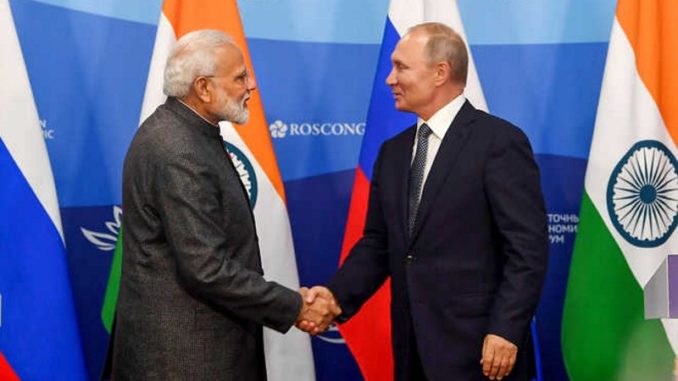
The India–Russia relationship stands deeply strained by larger geopolitical realities, but there is scope for improved ties

In a sense, the U.S. withdrawal from Kabul and India’s relationship with Moscow have helped New Delhi to adopt more flexible strategies vis-à-vis Afghanistan as well as the broader region. Given the close relationship that New Delhi enjoyed with Washington, American presence in Kabul had, in a way, limited India’s options as New Delhi was broadly encouraged to follow U.S. policy in the region. With the Americans gone, India can openly cooperate with Moscow and even Tehran, especially if the Joint Comprehensive Plan of Action (JCPOA) renegotiations succeed, and engage Afghanistan and the Central Asian region with their help.
The Russian President Vladimir Putin’s short visit to New Delhi and the inaugural 2+2 meeting between India and Russia — which is India’s fourth such engagement with another country — will help improve Moscow-New Delhi ties, currently fraying under the pressure of larger global power shifts. Of all the diplomatic balancing acts India has to play in this milieu of geopolitical uncertainty, the one with Russia is the most significant. And yet, let the ongoing flurry of activity between Moscow and New Delhi not blind us to the global forces that will pose formidable challenges for the partnership.
There are constraints
Russia, no doubt, is a friend in need to India; but Moscow’s friendship comes with limitations. Not only would the realities of the global balance of power shrink the robustness of the relationship over time, but, more crucially perhaps, a legacy relationship based on limited interaction might eventually lose the warmth given that there is little organic, people-to-people content to the relationship.
To put it bluntly, unless the bilateral ties can move beyond arms sale/purchase, the phase of stasis will kick in sooner rather than later in India-Russia relations. Consider for instance, the India-Russia bilateral trade is around U.S.$10 billion, far lower than India’s trade with China and the United States, China’s trade with the U.S. and Russia, and even the U.S.’s trade with Russia. The Soviet-era cultural and people-to-people contacts have almost entirely evaporated. Arms sales alone won’t a relationship make.
Today, the India-Russia relationship stands deeply strained by the larger geopolitical realities which neither of them is completely in control of. The quadrilateral dynamics among India, China, the U.S. and Russia have different implications of varying degrees for all four states in this relationship, in particular for India.
The dynamics
Let us use the concept of primary and secondary antagonisms to understand the dynamics of this quad better. To a great extent, if not entirely, the dynamics of this six-way relationship, at the apex, is a function of the U.S.-China rivalry. In this six-way matrix, China-U.S. antagonism is the first order relationship and the U.S.-Russia, China-Russia and Russia-India are the second order relationships. While the second order relationships in this quad are, to a great extent, a product of the primary antagonism, the second tier relationships also have their own unique dynamics and implications.
For instance, India-China, a second order relationship in this quad, is both a product of the primary antagonism between the U.S. and China as well as a result of the regional geopolitical rivalry between India and China.
Even though China remains its primary antagonism, Washington has not yet succeeded in divorcing its less challenging second order antagonism (rivalry with Moscow) from it. Washington’s parallel rivalries with China and Russia (albeit to a lesser extent) have complicated matters for New Delhi.
What appears to be a near certainty in the medium to longer term is that the dynamics of the quadrilateral relationship, in particular India’s tense relations with China, will go on to complicate India’s time-tested partnership with Russia, a process that has already started.
Even though Beijing has not aggressively attempted to damage India-Russia relations, there is little doubt that China will attempt to drive a wedge between New Delhi and Moscow since isolating India in the larger Asian region suits Beijing’s larger game plan.
A few scenarios
It gets more complicated if we were to examine the various potential scenarios in this quadrilateral relationship. For instance, the extent of Chinese aggression towards India will play a role in determining India’s relationship with Russia. Consider this. An aggressive China will push India towards the U.S., and even though Russia would be understanding towards India’s rationale behind such a pro-U.S. tilt in the medium term, India’s relationship with the U.S. will invariably create hurdles in India-Russia relations in the longer term. Russian Foreign Minister Sergey Lavrov’s warning to India should be read in that context: “We expressed our serious concern to our Indian friends over the U.S. activity there (Asia-Pacific region) under the slogan of so-called Indo-Pacific strategies and the creation of closed bloc-type structures”.
Put differently, the more aggressive Beijing gets towards New Delhi, the more India would grow closer to Washington and Moscow. However, while Moscow would appreciate a close partnership with New Delhi, it may not be when it comes to a growing India-U.S. partnership. More so, if Moscow has to choose between Beijing and New Delhi, it would choose Beijing just as New Delhi would choose Washington over Moscow if it comes to that.
This also implies that an aggressive China may also help increase India-Russia relations in the short to medium term, something we may already be witnessing. Recall Defence Minister Rajnath Singh’s visit to Moscow in June 2020 soon after the stand-off between Indian and Chinese troops on the Line of Actual Control to procure more weapons systems, among other things.
In the meantime, the seemingly unresolvable first order antagonism (the U.S. versus China) also provides space for geopolitical hedges in the second order partnerships/antagonisms, i.e., India-Russia and even Russia-U.S. For instance, Russia’s dormant concerns about China’s rising influence in its traditional periphery, and Moscow’s relations with India in the broader context of Central and West Asia and the western Indian Ocean could prompt Moscow to maintain a certain degree of, albeit limited, geopolitical hedge vis-à-vis Beijing. India’s desire for a robust relationship with Russia will be more appreciated by the U.S. due to the Chinese aggression against India and the U.S.’s systemic and first order rivalry with Beijing. More so, once the reality of the rise of China becomes a concern for Moscow, it could potentially open conversations with Washington to create a balance vis-à-vis Beijing which suits Indian interests. At the same time, however, if there is a rapprochement between the U.S. and Russia or a reduction in the war of words between the U.S. and China, this may or may not have a direct and substantive impact on Sino-Indian relations since the strains in Sino-Indian relations are not just a product of global balance of power but, more fundamentally, a result of India-China dynamics in the Southern Asian region. Put differently, no matter what the state of global geopolitics is, the essential (adversarial) nature of India-China relations is unlikely to undergo a fundamental transformation. For New Delhi, the principal antagonism is China. Therefore, New Delhi must exploit strategies and partnerships that can help address the China challenge more effectively. This means that India has to carefully balance its growing partnership with the U.S. with its somewhat delicate relationship with Russia.
Potential for cooperation
Let us return to the India-Russia ties and examine the potential for cooperation between the two sides. In a sense, the U.S. withdrawal from Kabul and India’s relationship with Moscow have helped New Delhi to adopt more flexible strategies vis-à-vis Afghanistan as well as the broader region. Given the close relationship that New Delhi enjoyed with Washington, American presence in Kabul had, in a way, limited India’s options as New Delhi was broadly encouraged to follow U.S. policy in the region. With the Americans gone, India can openly cooperate with Moscow and even Tehran, especially if the Joint Comprehensive Plan of Action (JCPOA) renegotiations succeed, and engage Afghanistan and the Central Asian region with their help.
If New Delhi plays its cards well, it can use Moscow to gain more geopolitical heft in the region — while the U.S. provided New Delhi status quo in the region, Moscow could provide India with more direct opportunities. Of course, New Delhi would need to be prepared for adverse reactions from Beijing and Islamabad.
Yet another area of cooperation between Moscow and New Delhi is the Indian Ocean Region, especially the western Indian Ocean where Russia has been expanding its influence and India has significant interests. For New Delhi, located in an unstable and virtually friendless neighborhood, friendship with Russia is important notwithstanding the structural limits to such a friendship. It will, therefore, take a great deal of diplomatic agility from New Delhi to stay the course and improve the relationship with Moscow amidst high-stakes geopolitical contestations.
(The author teaches at the Jawaharlal Nehru University, New Delhi and is the founder of the Council for Strategic and Defense Research)





Be the first to comment